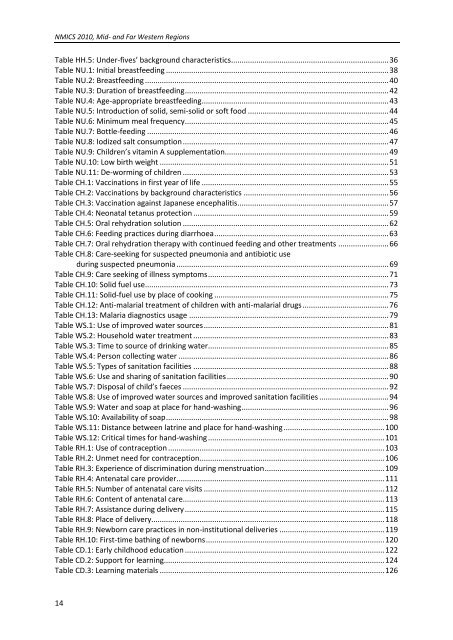NMICS 2010 Report - Central Bureau of Statistics
NMICS 2010 Report - Central Bureau of Statistics
NMICS 2010 Report - Central Bureau of Statistics
Create successful ePaper yourself
Turn your PDF publications into a flip-book with our unique Google optimized e-Paper software.
<strong>NMICS</strong> <strong>2010</strong>, Mid- and Far Western RegionsTable HH.5: Under-fives’ background characteristics ........................................................................... 36Table NU.1: Initial breastfeeding .......................................................................................................... 38Table NU.2: Breastfeeding .................................................................................................................... 40Table NU.3: Duration <strong>of</strong> breastfeeding ................................................................................................. 42Table NU.4: Age-appropriate breastfeeding ......................................................................................... 43Table NU.5: Introduction <strong>of</strong> solid, semi-solid or s<strong>of</strong>t food ................................................................... 44Table NU.6: Minimum meal frequency ................................................................................................. 45Table NU.7: Bottle-feeding ................................................................................................................... 46Table NU.8: Iodized salt consumption .................................................................................................. 47Table NU.9: Children’s vitamin A supplementation.............................................................................. 49Table NU.10: Low birth weight ............................................................................................................. 51Table NU.11: De-worming <strong>of</strong> children .................................................................................................. 53Table CH.1: Vaccinations in first year <strong>of</strong> life ......................................................................................... 55Table CH.2: Vaccinations by background characteristics ..................................................................... 56Table CH.3: Vaccination against Japanese encephalitis ........................................................................ 57Table CH.4: Neonatal tetanus protection ............................................................................................. 59Table CH.5: Oral rehydration solution .................................................................................................. 62Table CH.6: Feeding practices during diarrhoea ................................................................................... 63Table CH.7: Oral rehydration therapy with continued feeding and other treatments ........................ 66Table CH.8: Care-seeking for suspected pneumonia and antibiotic useduring suspected pneumonia ..................................................................................................... 69Table CH.9: Care seeking <strong>of</strong> illness symptoms ...................................................................................... 71Table CH.10: Solid fuel use .................................................................................................................... 73Table CH.11: Solid-fuel use by place <strong>of</strong> cooking ................................................................................... 75Table CH.12: Anti-malarial treatment <strong>of</strong> children with anti-malarial drugs ......................................... 76Table CH.13: Malaria diagnostics usage ............................................................................................... 79Table WS.1: Use <strong>of</strong> improved water sources ........................................................................................ 81Table WS.2: Household water treatment ............................................................................................. 83Table WS.3: Time to source <strong>of</strong> drinking water ...................................................................................... 85Table WS.4: Person collecting water .................................................................................................... 86Table WS.5: Types <strong>of</strong> sanitation facilities ............................................................................................. 88Table WS.6: Use and sharing <strong>of</strong> sanitation facilities ............................................................................. 90Table WS.7: Disposal <strong>of</strong> child’s faeces .................................................................................................. 92Table WS.8: Use <strong>of</strong> improved water sources and improved sanitation facilities ................................. 94Table WS.9: Water and soap at place for hand-washing ...................................................................... 96Table WS.10: Availability <strong>of</strong> soap .......................................................................................................... 98Table WS.11: Distance between latrine and place for hand-washing ................................................ 100Table WS.12: Critical times for hand-washing .................................................................................... 101Table RH.1: Use <strong>of</strong> contraception ....................................................................................................... 103Table RH.2: Unmet need for contraception ........................................................................................ 106Table RH.3: Experience <strong>of</strong> discrimination during menstruation ......................................................... 109Table RH.4: Antenatal care provider ................................................................................................... 111Table RH.5: Number <strong>of</strong> antenatal care visits ...................................................................................... 112Table RH.6: Content <strong>of</strong> antenatal care................................................................................................ 113Table RH.7: Assistance during delivery ............................................................................................... 115Table RH.8: Place <strong>of</strong> delivery............................................................................................................... 118Table RH.9: Newborn care practices in non-institutional deliveries .................................................. 119Table RH.10: First-time bathing <strong>of</strong> newborns ..................................................................................... 120Table CD.1: Early childhood education ............................................................................................... 122Table CD.2: Support for learning......................................................................................................... 124Table CD.3: Learning materials ........................................................................................................... 12614
















